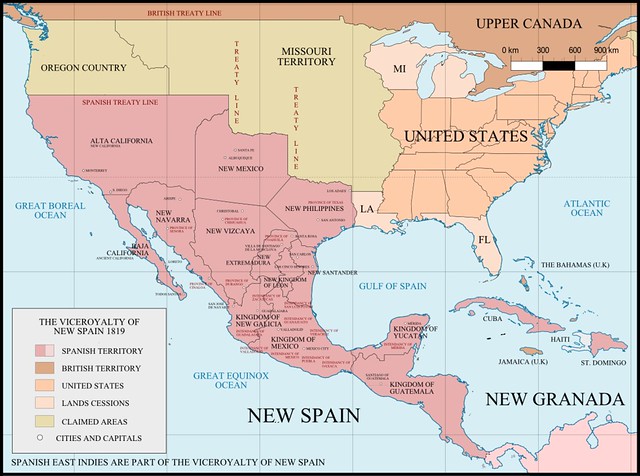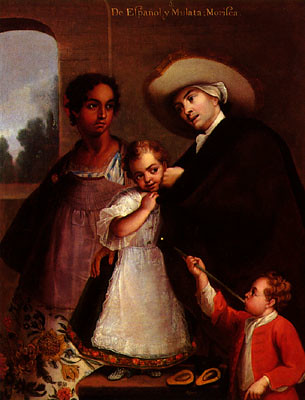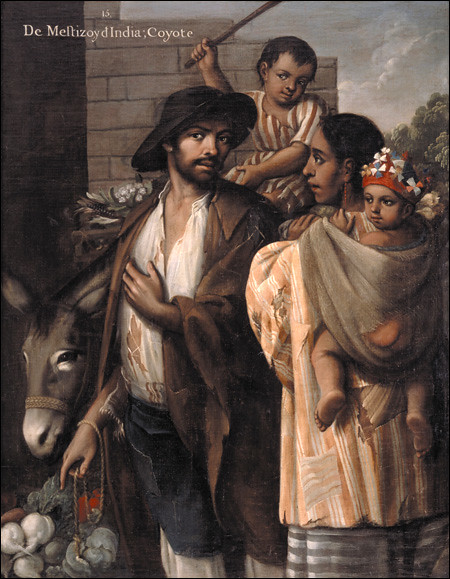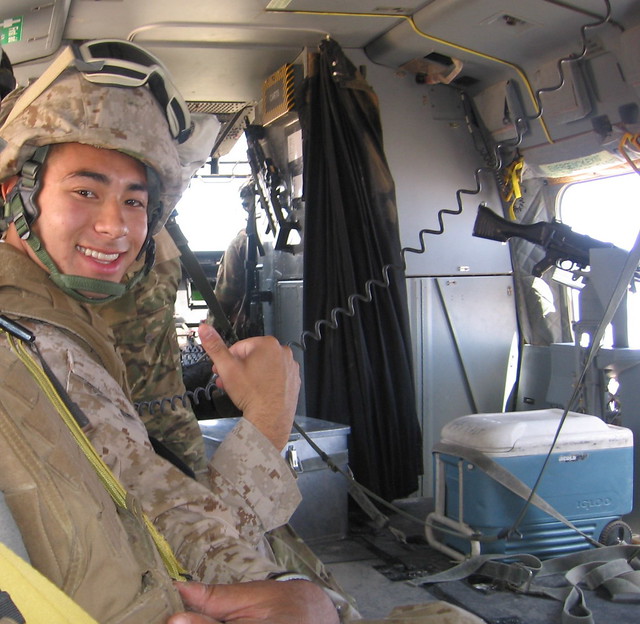American Me
http://open.salon.com/blog/escritora98/2012/04/30/american_me

New Spain in 1819 (Google Images).
Cinco de Mayo rolls around every year, and a bizarre claim crops up in news stories, political speeches, and in schools: Hispanics are “the newest immigrants” to arrive in the United States of America. ... Really?
Journalists, educators and provocateurs of all persuasions parrot this dubious assumption within the context of the immigration debate, as they pander for votes, or attempt to tap into billions of dollars in targeted marketing.
These would-be pundits tack Hispanics on the end of the U.S. immigration timeline, and regurgitate allegations that these “newcomers” are not learning English or assimilating into mainstream U.S. society. As a bona fide English-speaking Hispanic American whose roots in the United States run centuries deep, I feel compelled to set the record straight.
Before I begin, let me clear the air for any conspiracists who happen to be reading: No. I’m not an illegal immigration apologist or supporter, an “open borders” advocate, a historical revisionist, or a rabid secessionist who wants the U.S. to return the Southwest to Mexico. Please.
When I hear the claim that Hispanics are “new immigrants” to the United States, here’s what happens in my mind: With a Harry Potter-like incantation, the pages of an enchanted history book flip backward at warp speed, erasing generations of my family. Just like that—Poof!—they are gone. Obliviate historicus!
Gone are the seven generations of my Spanish-surnamed family that have lived in Colorado; gone are the generations of my family dating back to the 1700s in Spanish colonial New Mexico; and gone are my indigenous ancestors who lived in North America for millennia before everyone else arrived.
Gone, too, are the generations of pioneering Hispanic American women in the Southwest who farmed, ranched, birthed babies in adobe houses, and knew their way around rosaries, deer carcasses, horses and guns.
Our nation’s collective amnesia about U.S. history and the history of the Americas in general—from Greenland to the tip of Cape Horn—is staggering it its scope. We may live in the digital age, but many of us still buy into a compartmentalized, anachronistic pop lore that goes something like this:
Columbus “discovered America” in 1492; the Mayflower landed at Plymouth Rock in 1620; English colonists defeated the British and established a new republic; cowboys and Indians fought through Manifest Destiny; Texans fought Mexicans; the North fought the South; everyone else passed through Ellis Island; and now Hispanics are arriving late—and not so fashionably—to the party.
The conquerors may write official history, but this fabula is too much, even for us. No doubt William “Bill the Butcher” Poole, his gang of Bowery Boys, and their Know Nothing cohorts would support this narrow national narrative, but I prefer to look at things a bit more holistically.
For starters, didn’t a lot of people already live in the Americas for millennia before everyone else arrived? You know, the Carib, Arawak, Maya, Aztec, Inca, Anasazi, Pueblo, Apache, Cherokee, Lakota, Ute, Arapaho, Osage, Wichita, Walla Walla, Wampanoag and hundreds, if not thousands, of other American Indian tribes? (The Vikings colonized Greenland for an impressive 500 years, but apparently left no permanent settlements).
Secondly, didn’t a lot happen over the 128-year span between the arrivals of Columbus and the Mayflower?
I believe the Spanish, Portuguese, British and French explored, colonized and “conquered” their way across the Americas long before the first Pilgrim landed in New England. With them, those early European explorers brought enslaved Africans, Sephardic Jews fleeing the Spanish Inquisition, and sailors, soldiers and laborers from across Europe, China, India and the Middle East.
Waves of immigrants have been arriving ever since. One thing is for certain, though, early Hispanic colonists did not pass through Ellis Island because there was no Ellis Island when they arrived. Ellis Island opened in 1892, and by then Hispanics had been living in the Southwest for almost 300 years.
Hispanics have been part of the American story all along.
 The Battle of Xochipilla during the Miztón War in 1541 in what is present-day Mexico. In this painting, Spanish colonizers and an opposing tribe wage war on the Aztecs. (Google Images).
The Battle of Xochipilla during the Miztón War in 1541 in what is present-day Mexico. In this painting, Spanish colonizers and an opposing tribe wage war on the Aztecs. (Google Images).
Truth is, Hispanics—the Spanish-surnamed, multiracial progeny of conquering Spaniards, vanquished American Indians and enslaved Africans—have been part of the mix from day one, and we’ve been justifying our existence ever since.
What with our conflicting, complex, cultural legacies of conquest, Catholicism, and casta, Protestant America just hasn’t known what to do with us. It’s easier to pretend we just arrived from modern-day Mexico, than to admit we’ve been here all along. That would disrupt the cozy fabula we teach our children.
Call it a “black legend,” but our Spanish ancestors, who arrived with Columbus and after him, began enslaving, converting and torturing our American Indian ancestors as they expanded and charted northward into “New Spain” in a bloody, brutal and short-sighted quest for gold and new territories.
Ask indigenous people across the Americas and they will tell you that what Spanish conquistadores and viceroys did to their tribes, cities and sacred sites between 1492 and 1810 makes other human atrocities look minor by comparison.
Sí. We’ve struggled with our conflicting legacies, but Hispanics have been in the Americas, including the United States, all along.
In fact, the oldest, permanent European settlements in the U.S. were founded by Spaniards on the ruins of the American Indian villages they destroyed: St. Augustine, Fla., in 1565, and Santa Fe, N.M., in 1598.
Generations before Santa Fe became an artsy enclave for the rich, the Spanish in 1610 built San Miguel Mission, the oldest Christian church in the United States.
A few centuries before Hollywood and the Silicon and Napa valleys became trendy, Spain’s King Charles III established California’s 21 Catholic missions in the 1700s to thwart Russian settlement.
In 1851, long before Colorado saw its first ski resort, Spanish-speaking colonists from New Mexico founded San Luís, the state’s oldest non-indigenous town.
Here are a few more Spanish names: California, Arizona, Colorado, Nevada, Nuevo Mexico, Florida, Montaña, Los Angeles, San Francisco, Sacramento, San Antonio, Amarillo, Los Alamos, Las Vegas, Sierra Nevada and Río Grande.


One of the "casta" paintings by renowned Zapotec painter Miguel Cabrera, c. 1763. Painting portrays a mestizo (Spanish/Indian) male with his Indian wife.
There’s so much evidence of our diversity. Yet millions of Americans claim ignorance about the Spanish colonization of a huge chunk of North America, and the people who arose from that chapter of history: the Mexican Americans, Hispanos, Sephardic Jews and Basques who have lived in the United States for generations.
I’ve never been to Louisiana, but I know about Cajuns. I know about the Italians and Jewish in New York, the Polish in Chicago, the Irish in Boston, the issei and nisei in San Francisco, the Scandinavians in Minnesota, the Germans, Dutch and Amish in Pennsylvania, the people of Appalachia, the Slovenians in southern Colorado, and the African diaspora across the Americas.
I also know about the Puerto Ricans in New York, the Cubans in Florida, and about recent Latin American immigrants who have fled poverty, drug violence and dictatorships to stake their claims in the United States after crossing international borders legally and, yes, illegally in often harrowing circumstances.
‘Dude, Where Did All These Mexicans Come From?’
One reason for widespread ignorance about the long presence of Hispanics in the United States may stem from the fact that generations of Hispanic families have been classified as “white” or “caucasian” in census after census.
Before the 1960s, if you had a Spanish surname, and didn’t live on a reservation, you were “white,” though that government-sponsored designation earned you none of its built-in privileges and upward mobility.
Recently, the federal government released the 1940 census, and all I heard from news organizations was “how white we used to be.” Not one mainstream journalist challenged the data, or reported the diversity of stories behind the story:
1940s: My great-uncle and stepfather served with “white” troops during World War II because the government didn’t know how to classify Hispanics. Yes. We were fighting the Nazis and the Axis alliance, and our own troops were segregated.
1950s: While serving in the military in the South, my fair-skinned uncle and his brown wife threw the segregated South for a loop when they entered a cafeteria—and Southerners didn’t know where to seat them.
1960s: New Englanders repeatedly asked another uncle in uniform where he had learned to speak English “like a native.”
My uncles, father and stepfather weren’t alone in serving the U.S. Some 170,000 Hispanics served in Vietnam; 140,000 volunteered for Korea; and as many as a half-million served in World War II. Hispanics served in World War I, the Civil War, and were even present during the American Revolutionary War.
More recently, my brother served in the Gulf War, and nephews and cousins have served or are stationed at points across the globe.

My great-uncle, Frank, in his World War II uniform.

My father, John, in his Army uniform in 1953.

That the growing presence of Hispanics surprises so many Americans does not detract from this simple fact: the United States and Latin America have been neighbors for centuries and share a common history.
Mexico declared its independence from Spain in 1810, and later lost a third of its land to the United States during the Mexican-American War.
After the dust settled, a lot of Spanish-surnamed families remained on the U.S. side of the border in a hybrid subculture that was neither Spanish, Mexican, American Indian, nor completely Yankeefied (Believe me. It’s not for lack of trying).

This photo was shot by American photojournalist Russell Lee in 1949 in San Antonio, Texas. Lee documented the ethnography of various American socioeconomic classes and cultures. (Courtesy of the Center for American History, University of Texas).
According to the Pew Hispanic Center, part of the Pew Research Center, a nonpartisan “fact tank” in Washington, D.C., the Hispanic presence will continue to grow. Hispanics/Latinos are expected to make up 29 percent of the U.S. population by 2050, more than double the figure reported in 2005.
As a mestiza, a hybrid, someone who carries both the blood of the conquerors and the conquered, all I can do is teach my multiracial, multinational, bilingual children to honor the dead, and to remember their multifaceted history, which is, essentially, the history of the Americas.
My children know that being “American” has nothing to do with race, ethnicity, religion or skin color, no matter what anyone tells them, and, if longevity is a measure of how American we are, then we are among the most American of all.
My half Irish-American son already knows he has something in common with baseball great Ted Williams, actors Rita Hayworth, Martin Sheen and Anthony Quinn, and folk singer Joan Baez: Like him, all had a Hispanic parent.
My half-Venezuelan daughter bridges the worlds of U.S.-born Latinos and Latin Americans with ease and in two languages. Her son is half Hispanic and half Anglo, and will be proud of all sides of his family history.
Colonialism through brute force, be it Spanish, English, Portuguese or French, isn’t anything to be proud of, but it’s an immutable part of the history of the Americas, Africa, Australia and other parts of the globe, and no amount of regret, guilt, self-hatred, wishful thinking, historical whitewashing, government apologies, monetary settlements or retrofitted museum exhibits will ever change that fact. All we can do is admit it, learn from it, and build a better world on its ashes.
We may be the end result of European colonization and conquest, but our hearts and minds don’t have to be conquered, mutilated, vanquished and diminished. Our history doesn’t have to be erased, denied, forgotten or downplayed. We can be U.S. citizens and proud of our ancestral heritage, too. As Americans, we know the two are not mutually exclusive.
Hispanics are still here, and we are not all recent immigrants.
Carajo pana (quasi equivalent of “crikey mate”), why that surprises so many in this day and age is just baffling.
-30-
Terminology
America - A land mass that encompasses North, Central, South America and nearby islands. Often used in the U.S. to describe the United States of America.
American - Any person born or naturalized legally in the Americas. Traditionally used by U.S. citizens to describe themselves (see above).
Cinco de Mayo - The anniversary of an 1862 battle in Puebla, Mexico, where Mexican forces defeated invading French troops. A holiday in parts of Mexico, and in the U.S. as a generic way to market to Hispanic Americans.
Hispanic - A generic, umbrella, cultural term for people in the United States who claim some measure of Spanish heritage through language, surname, history, blood or geography. Hispanic Americans can be of any “race” or mixture thereof (and usually are), and may or may not have ties to modern Spain and/or Latin America. Often used interchangeably with Latino.
Latino/Latina - A catch-all term for anyone of Hispanic origin. Takes the emphasis off the Spanish, and puts it on Latin America, which implies an homage to mestizo (racially mixed) heritage and roots. Preferred by new Latin American immigrants as a general classification, when they are not describing themselves by their non-U.S. nationality (i.e. Venezuelan, Cuban, Argentine, Colombian, etc.)
Spanish - The language spoken by an estimated 400 million people across Latin America, in Spain, and in the U.S. Once used in the United States as a “polite” term for Hispanics, or by Hispanics who denied or downplayed their American Indian heritage, buckling under the pressure of rampant anti-Indian racism.
United States of America - A large, multicultural, multiracial nation of 300 million people whose official government was founded by British colonists and revolutionaries, but whose diverse human history dates back millennia and encompasses innumerable, untold stories of many peoples in many regions—from the hemisphere’s original American Indian inhabitants to all the rest.
List of English Words Borrowed from Spanish
Suggested reading:
- 1491: New Revelations of the Americas Before Columbus, by Charles C. Mann
- 1493: Uncovering the New World Columbus Created, by Charles C. Mann
- Harvest of Empire: A History of Latinos in America, by Juan González
- Brown: The Last Discovery of America, by Richard Rodríguez
- On the Edge of Purgatory: An Archaeology of Place in Hispanic Colorado, Bonnie J. Clark
For your viewing and listening enjoyment:

No comments:
Post a Comment